Summer stars from warmer climates

When we are all, hopefully, enjoying the hotter more humid days in July and the longer evenings there is a different range of plants that come into their own in our gardens, ones found naturally close to the equator or in the upper reaches of the Southern hemisphere. These plants are always sought after, as they take centre stage in the garden, often flowering from July until late into the autumn. Their flowers come in much richer colours, pigment-packed petals designed to defy strong sunshine to make your garden glow. These colourful plants include fuchsias, dahlias, penstemons, slightly tender salvias, kniphofias and agapanthus, and July is a great time to plant them because the soil is warm enough to promote good root growth. But don’t forget you will have to water them if the summer’s dry,- they do still need water.
The South American plants are dazzlers. Some enjoy wet summers because they originate from species found naturally on the eastern side of The Cape, an area that catches the outer edges of the monsoon rains in summer. Consequently crocosmias, many red hot pokers and most agapanthus thrive in wet British summers, or in high rainfall areas.
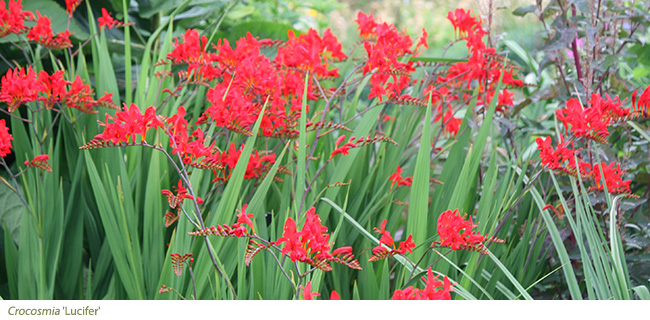
Crocosmias have the added advantage of sword-shaped foliage, which is invaluable because the larger ones add bold upright accents to the border breaking up the rounded mounds most perennials form. ‘Lucifer’ is a statuesque July-flowering warm red and the foliage is pleasingly pleated hinting at one of its parents C. masoniorum. This normally flowers 3-4 weeks later than ‘Lucifer’ and the branching, smaller flowers, arranged in a herringbone pattern, are more of a burnished copper-red. The seed heads remind me of a skein of birds in flight.
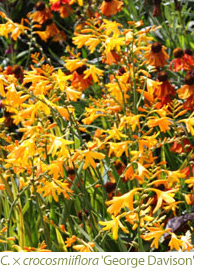 Not all crocosmias are orange, there are yellows too. ‘George Davison’ is taller than most and really hardy having been bred in Norfolk over a hundred years ago and named after the Head Gardener of Westwick Hall in Norfolk. ‘Orange Pekoe’ is a new one with open star-shaped flowers flushed in orange and yellow. It’s a front of the border plant, being about a foot in height, and flowers in August. Crocosmias are rabbit resistant, which is worth keeping in mind if you live in the country.
Not all crocosmias are orange, there are yellows too. ‘George Davison’ is taller than most and really hardy having been bred in Norfolk over a hundred years ago and named after the Head Gardener of Westwick Hall in Norfolk. ‘Orange Pekoe’ is a new one with open star-shaped flowers flushed in orange and yellow. It’s a front of the border plant, being about a foot in height, and flowers in August. Crocosmias are rabbit resistant, which is worth keeping in mind if you live in the country.
Kniphofias, or red hot pokers, provide even stronger verticals and they come in a range of colours including orange. This colour is often shot down by the style police, but it sets off purples, blues and mauves, so be brave! The tall K. uvaria reaches four feet or more and one good plant can send out 50 flowers in early August. They emerge orange and develop a yellow ruff at the base of the spike, but they are full of nectar and wasps flock to them. Knock up against them and their flowers will shower you with nectar.
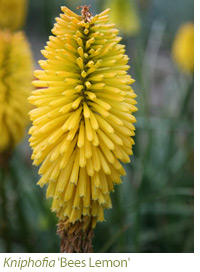 ‘Bees Lemon’ adds cool lemon tones and the green-tipped flowers are produced in flushes during August and September. ‘Tawny King’ comes in shades of cream and caramel and this was deliberately bred by John May in the 1990s. Frisk the foliage of all pokers in spring because snails roost there and can be a problem.
‘Bees Lemon’ adds cool lemon tones and the green-tipped flowers are produced in flushes during August and September. ‘Tawny King’ comes in shades of cream and caramel and this was deliberately bred by John May in the 1990s. Frisk the foliage of all pokers in spring because snails roost there and can be a problem.
Agapanthus, often pot grown, is an equally thirsty plant although there is a myth that you should starve them. This is completely wrong. Regular fortnightly feeding, with potash-rich liquid tomato food, and regular watering produces far more flower on a plant of greater stature. Deep blue varieties include ‘Northern Star’, my desert island agapanthus. This produces seriously neat, dark blue flowers with darker midribs to each petal. The stems are dark and strong, almost rubbery to the touch, and the foliage is refined and low with dark basal markings. This was bred by Plant Heritage Collection holder Dick Fulcher who lives on the edge of Dartmoor, so agapanthus are hardier than most think. ‘Black Pantha’ is darker, with almost black buds and glistening violet flowers.
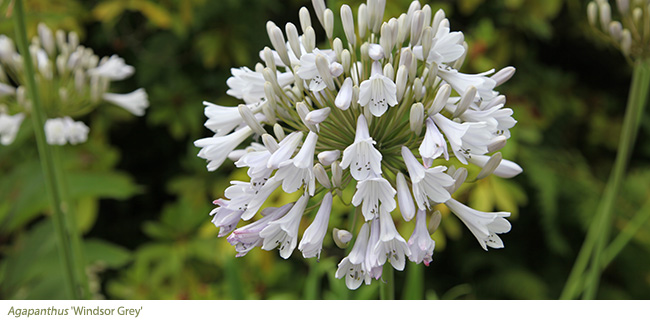
Not all agapanthus are blue and the tall ‘Windsor Grey’ offers a paler alternative, so stand your pot in good light so that it glows, but doesn’t get washed out by full summer sun. This agapanthus sets seed and these pods should be removed after flowering to keep the vigour in the plant. Lilac flowered agapanthus tend to be smaller but ‘Liam’s Lilac’, another Dick Fulcher agapanthus, is taller reaching 1m or so.
In colder regions agapanthus can stay in their pots over winter. The best way to prepare them for the cold is to ease off the watering from early September and dry them off. Take them in when the weather gets cooler, although they can survive a frost or two. Keep them somewhere frost-free until March. Then begin to water them a little. They can go back outside in May. If they need dividing, a difficult job for some involving a strong arm and saw, do it in March or April as the plants start into growth.
 South America is a rich source for late-summer bloomers and often these have deep red in their constitution. Fuchsias can make a huge contribution from August onwards and some of the shrubbier fuchsias bear small, elegant flowers and are hardy enough to survive in the garden from year to year. Fuchsia ‘Riccartonii' has small single flowers in iconic fuchsia colours - red and purple - and will form a roundel of 2m on average. Fuchsia magellanica var. molinae has pink flowers with paler sepals above a deeper pink corolla and the stamens hang down low. ‘Hawkshead' is a cool white best grown in some shade.
South America is a rich source for late-summer bloomers and often these have deep red in their constitution. Fuchsias can make a huge contribution from August onwards and some of the shrubbier fuchsias bear small, elegant flowers and are hardy enough to survive in the garden from year to year. Fuchsia ‘Riccartonii' has small single flowers in iconic fuchsia colours - red and purple - and will form a roundel of 2m on average. Fuchsia magellanica var. molinae has pink flowers with paler sepals above a deeper pink corolla and the stamens hang down low. ‘Hawkshead' is a cool white best grown in some shade.
These shrubby fuchsias are left intact overwinter and then pruned in spring, back to highest shooting leaves. They can be used on a corner of a border in good light, but not full sun. Or they can be combined with Japanese anemones which rise above them and ramble through them. The classic white Anemone × hybrida 'Honorine Jobert’ flatters the red and purple hardy fuchsias and ‘Bowles’s Pink’ is a vivid pink suited the paler-flowered forms.
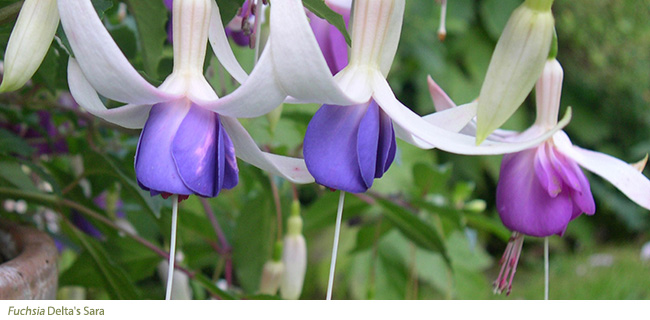
There are also showier hardy fuchsias with much larger flowers and these can reach a metre in height. ‘Mrs Popple’ was discovered in the 1920’s and she combines purple and red in a globular flower that’s elegant, with no frill in sight. The new ‘Delta’s Sara’ has pale-pink sepals and a blue pink corolla, with the added bonus of having bright pink stamens.
 Salvias, from South America, are magnificent in late summer and autumn and are often the last flower standing. The easiest to grow are short woody-stemmed ones with smaller flowers such as Salvia microphylla. S. × jamensis ‘Nachtvlinder' is easy too, and has deep purple flowers which look best popping up close to yellow achilleas such as ‘Moonshine’, or with silvery foliage. ‘Royal Bumble’ (another good one) is a sensational red made better by having full flowers encased in very dark calices, and held on equally dark stems. In a sunny well-drained spot both should come through winter. Salvia greggii isn’t quite as hardy but the flowers come in a wider range of colours and ‘Icing Sugar’ has two-tone pink flowers. Take this in in winter.
Salvias, from South America, are magnificent in late summer and autumn and are often the last flower standing. The easiest to grow are short woody-stemmed ones with smaller flowers such as Salvia microphylla. S. × jamensis ‘Nachtvlinder' is easy too, and has deep purple flowers which look best popping up close to yellow achilleas such as ‘Moonshine’, or with silvery foliage. ‘Royal Bumble’ (another good one) is a sensational red made better by having full flowers encased in very dark calices, and held on equally dark stems. In a sunny well-drained spot both should come through winter. Salvia greggii isn’t quite as hardy but the flowers come in a wider range of colours and ‘Icing Sugar’ has two-tone pink flowers. Take this in in winter.
Large flowering, tall salvias include ‘Amistad’, a relatively new salvia originally spotted in a small nursery in Buenos Aires cicrca 2005. The dark blue flowers are held in almost black calices and positioned on one side of the tall dark stem, held above bright green foliage. Stems can reach a metre high, and ‘Amistad' will flower for months. It has Salvia guaranitica, a species found in a wide area that includes Argentina and Brazil, in its bloodline, so it’s best to take it in during winter unless you live in the banana belt of the south-east. Then showy three wishes ('Love and Wishes', 'Wendy’s Wish' and 'Ember’s Wish') were bred in Australia and they will need a frost-free place to overwinter. They have large flowers and make robust plants and are very willing to flower by late summer.

You can also rely on dahlias for late-season colour. One of the very best is ‘David Howard’ a butterscotch-orange fully petalled decorative with khaki foliage. It arose as a seedling from another iconic dahlia with red semi-double flowers and black ferny foliage, the ‘Bishop of Llandaff’. Both will give you late-summer razzamatazz and both perform in cooler summers too.












